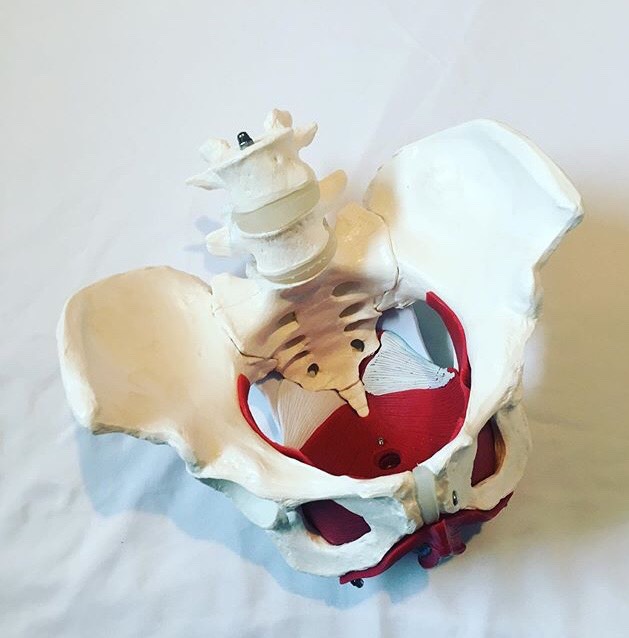 Hi friends! I’m so excited to be sharing today’s post in collaboration with my pelvic floor physiotherapist, Stephanie Brown, from Choice Health Centre in Halifax. I’ve been meaning to get this post up for weeks but I was struggling to choose what photo to use for the post…so random right!? But how do you decide on a “cute” photo for a blog post on pelvic floor physio…I certainly wasn’t going to be showing a shot of me at one of my appointments…that’s just getting WAAAY to personal, haha! ANYWAY I decided to go with this photo our wedding photographer shot of me almost a year to the day when my belly was just starting to show and when I really should have started pelvic floor physio but more on that below!
Hi friends! I’m so excited to be sharing today’s post in collaboration with my pelvic floor physiotherapist, Stephanie Brown, from Choice Health Centre in Halifax. I’ve been meaning to get this post up for weeks but I was struggling to choose what photo to use for the post…so random right!? But how do you decide on a “cute” photo for a blog post on pelvic floor physio…I certainly wasn’t going to be showing a shot of me at one of my appointments…that’s just getting WAAAY to personal, haha! ANYWAY I decided to go with this photo our wedding photographer shot of me almost a year to the day when my belly was just starting to show and when I really should have started pelvic floor physio but more on that below!
Pelvic floor physiotherapy isn’t something I’d ever heard of until I was around 8ish months pregnant when I shared on Instagram that I thought I might have diastasis recti (or separation of the abs from pregnancy). One of my Instagram friends reached out and suggested that I go to pelvic floor physio at Choice Health Centre postpartum after my 6-week check up. I was so intrigued by this and booked an appointment when the time came still not really knowing what it was.
At my first appointment, Stephanie and I had a long discussion about my birth experience and how I was feeling postpartum. I actually cried in her office because she was just so sweet and understanding and really made me feel like I wasn’t alone in how my body, and mind for that matter, were feeling. She also assured me I wasn’t the first to cry at an appointment so that made me feel better to. After our chat, Stephanie assessed the “damage” and to my surprise I didn’t have DR but I did quite a few issues going on downstairs (that I would also like to point out were NOT mentioned by my doctor at my 6-week checkup) LOL! I had an extremely traumatic birth experience and when I look back on now it was way more intense than I initially thought. I’ve actually had flashbacks to it and it’s taken me a while to process and come to terms with. I had to have an episiotomy and forceps were used to get Edwin out and let’s just say it has taken my body months to recover…and it still is! Thankfully, Stephanie came into my life because she has slowly but surely helped get my pelvic floor back to tip top shape and I could not be more grateful for not only the work she’s done but for how comfortable she’s made me feel (especially since as women, we’re in such a vulnerable position postpartum).
Pelvic floor physio has been an invaluable part of my postpartum healing journey and my only regret is that I wish is that I had started as soon as I became pregnant (note to all you mamas to be out there!!!). I wanted to share a Q&A with Stephanie about PFP because I think it is something not many women know about or many they do but they may not be exactly sure what it is and what to expect.
I swear, pregnancy, postpartum healing and babies should all magically come with a guide book because navigating all of these things can be a difficult road. I truly hope that this post helps with at least a little bit of that!
What exactly is the pelvic floor?
The pelvic floor is a group of muscles, ligaments and tissues within the pelvis. The muscles form a hammock or sling which attaches at the pubic bone at the front of the pelvis, to the ischial tuberosities (sitzs bones) at the sides of the pelvis, and ends around the coccyx (tailbone) at the back of the pelvis. The pelvic floor helps assists with bladder, bowel and sexual function and is also a very important core stabilizer.
Here are 2 photos of models of the pelvic floor for reference:


What are the benefits of Pelvic Floor Physiotherapy?
There are so many! Obviously good function of our bladder, bowels and sexual organs is important to a healthy and fulfilling lifestyle. If you had a sore back or knee, chances are you would go to your doctor to get it looked at and would likely be referred to a physiotherapist for treatment. Same applies to your pelvis and pelvic floor but for some reason we all neglect that area. If you are having trouble with your bladder, perhaps you pee/leak when you don’t want to, you pee too much, or you can’t control your pee – that is a sign of pelvic floor dysfunction. If you are chronically constipated or have pain or trouble with bowel movements that could be related to your pelvic floor. If you experience pain every time you try to have intercourse or penetration, that is also not normal. These are just some of the issues a pelvic floor physiotherapist can help with.
Who should see a Pelvic Floor Physiotherapist?
Firstly, every single women who has ever had a baby – vaginal or cesarean birth. Interestingly, in France every single women is given 10 free sessions paid for by the government to see a pelvic floor physiotherapist after giving birth. That is how important this is. If you have not had children but experience trouble controlling or emptying your bladder, urgency to pee, heaviness or pressure in the pelvis, difficulty emptying your bowels, painful tailbone, or pain with intercourse you should see a pelvic floor physiotherapist. Also, if you are menopausal there are many changes in the hormones, muscles and tissues related to the pelvis, so it’s a good time to visit a pelvic floor physiotherapist as well.
Why should you see a Pelvic Floor Physiotherapist?
To make sure your pelvic floor is functioning properly because it impacts your bladder, bowel, core and sexual function. Low back and hip pain can also be linked to pelvic floor dysfunction. A 2018 study by Dufour, Vandyken B, Vandyken C and Forget found that 95.3% of women with lumbo-pelvic pain had pelvic floor dysfunction (1).
If you are pregnant, do you have to wait to give birth before seeing a Pelvic Floor Physiotherapist?
No. You can see a pelvic floor physiotherapist anytime after the first trimester. It is always a good idea to mention it to your doctor or midwife just to be sure there is no medical reason preventing you from having the internal exam performed by a pelvic floor physiotherapist. Typically if your doctor has not told you to refrain from sexual intercourse you are usually fine to see a pelvic floor physiotherapist – but I always feel it’s best to discuss it with them first.
Does Pelvic Floor Physiotherapy hurt?
It shouldn’t hurt but it can be uncomfortable. There are certain conditions of the pelvic floor that cause a lot of muscle tension or tightness. Sometimes when we touch these muscles they can be quite tender but it is never our intention to cause pain. Think of it like going to a massage therapist for your back. The muscles can feel quite tender when they are getting massaged but the intention is to help them relax. The pelvic floor muscles can have trigger points and areas of tension in the same way. Pelvic floor physiotherapist use a lot of hands-on manual release techniques to help muscles relax.
What should I expect at my Pelvic Floor Physiotherapy appointment?
A physiotherapist who is trained in pelvic health can address issues with urinary dysfunction, sexual dysfunction, bowel dysfunction, pain disorders involving the pelvic floor, and pelvic organ prolapse. We do this by taking a thorough history and performing a comprehensive internal examination of the vagina and often rectum as well.
In order to perform a good assessment we need to feel the pelvic floor muscles, and this is best done internally. This may sound a little intimidating, but rest assured your physiotherapist will go above and beyond to ensure your comfort and perform the assessment in the most respectful way possible. Everything will be explained to you so you know exactly what is happening every step of the way.
Should everyone do kegels? What are some common misconceptions about Kegel exercises?
No not everyone should do kegels. If there is already a lot of tension or tightness in the pelvic floor muscles, doing kegels can actually make symptoms worse. This is why it is so important to see a pelvic floor physiotherapist because we are trained to specifically look at the muscles inside the pelvis to see if they are too tight or too weak. A high percentage of women have no idea how to properly contract their pelvic floor – aka Kegel – so you could put a lot of effort into this exercise but not be doing it right.
Is the pelvic floor affected by breastfeeding?
Yes. When you are breastfeeding the body is in a lower estrogen hormone state. This can cause some vaginal dryness and weakening of the pelvic floor muscles. This is not a reason to stop breastfeeding but good information to know. In fact, it was reported in The American Journal of Obstetrics and Gynecology that there was no association found between breastfeeding and pelvic floor dysfunction 1-2 decades after delivery (2). So although being in a low estrogen state can affect the pelvic floor temporarily, there appears to be no long term effects. The hormone levels typically balance a few months after a mother stops breastfeeding.
About Stephanie Brown?
Stephanie Brown is a Registered Physiotherapist with the Nova Scotia College of Physiotherapists, a long standing member of the Canadian Physiotherapy Association and member of the Women’s Health Division. She completed her Bachelor of Science Kinesiology in 2004 and Bachelor of Science Physiotherapy in 2007 at Dalhousie University. Since graduating she has worked in a variety of settings both in the public and private sector.
Stephanie works exclusively in Women’s Pelvic Floor Physiotherapy. Having two young children herself, Stephanie has personally struggled with pelvic issues during pregnancy and post-partum. This has led to a passion for educating and helping other women struggling with similar issues. Stephanie has completed post graduate training in The Physical Therapy Approach to Women’s Incontinence, The Physical Therapy Approach to Dyspareunia (painful intercourse), and Physiotherapy for Ano-Rectal Disorders. Stephanie is also a certified Core Confidence Specialist, Pre-Post Natal Fitness Specialist, and Yoga Exercise Specialist. She maintains a strong relationship with the community by providing educational talks on Women’s Health issues at a variety of public venues and events.
References
1. Association between lumbopelvic pain and pelvic floor dysfunction in women: A cross sectional study. Sinéad Dufour, PT PhD, Brittany Vandyken, MScPT, Marie-Jose Forget, BScPT, Carolyn Vandyken, BScPT. Musculoskeletal Science and Practice.
April 2018, Volume 34, Pages 47–53.
2. Does breastfeeding worsen pelvic floor disorders? American Journal of Obstetrics and Gynecology. International Clinical Digest. May 21, 2019.



